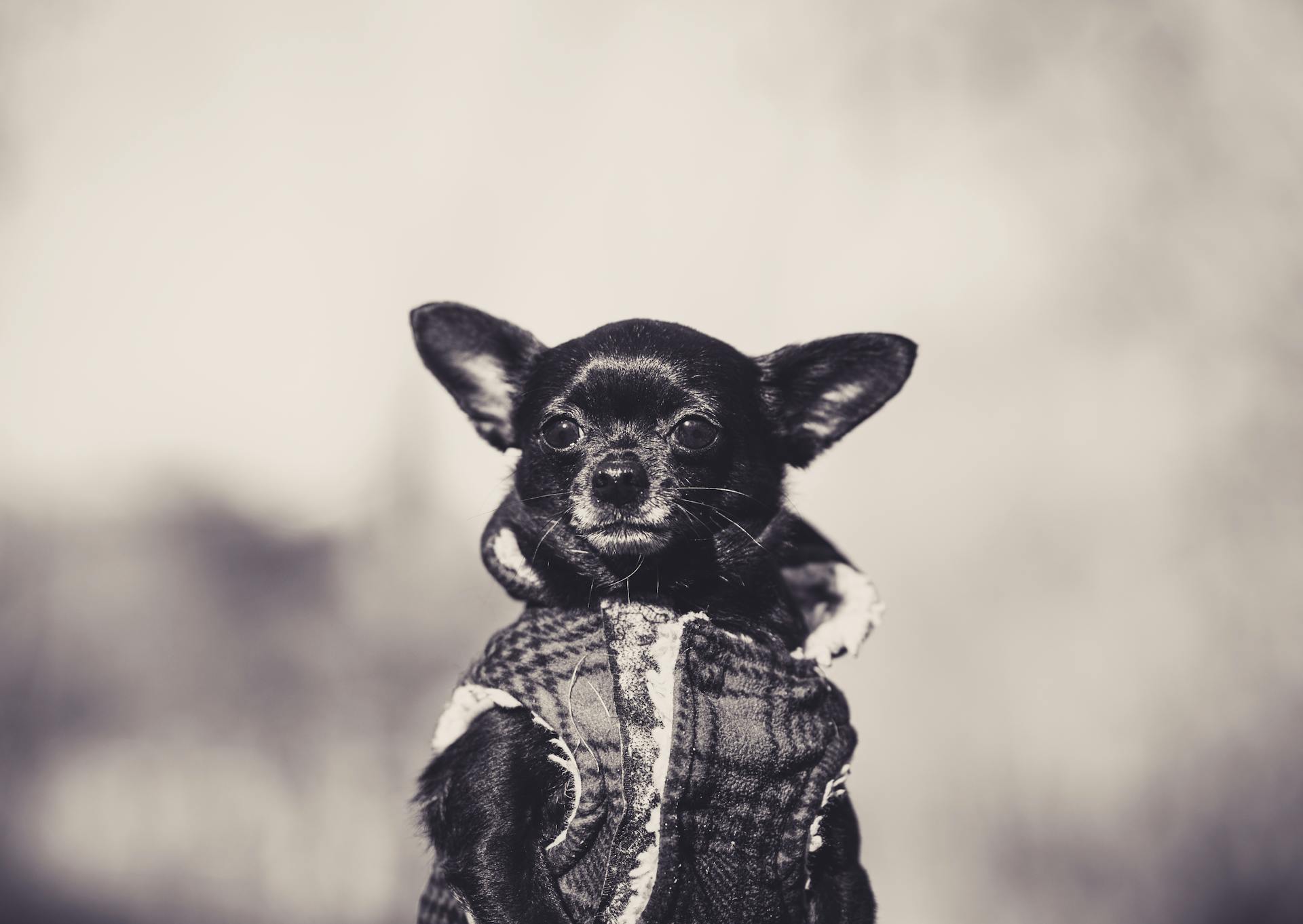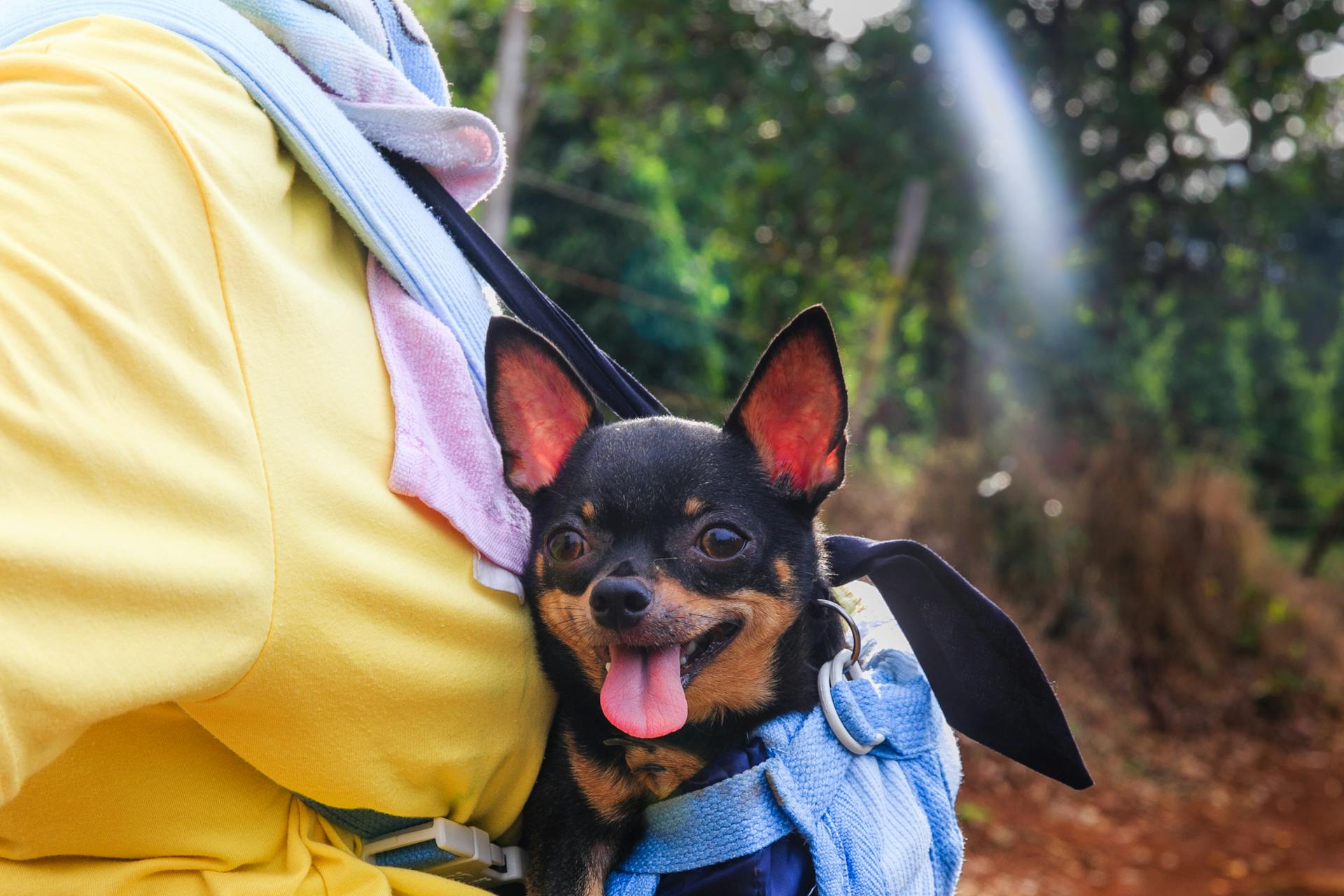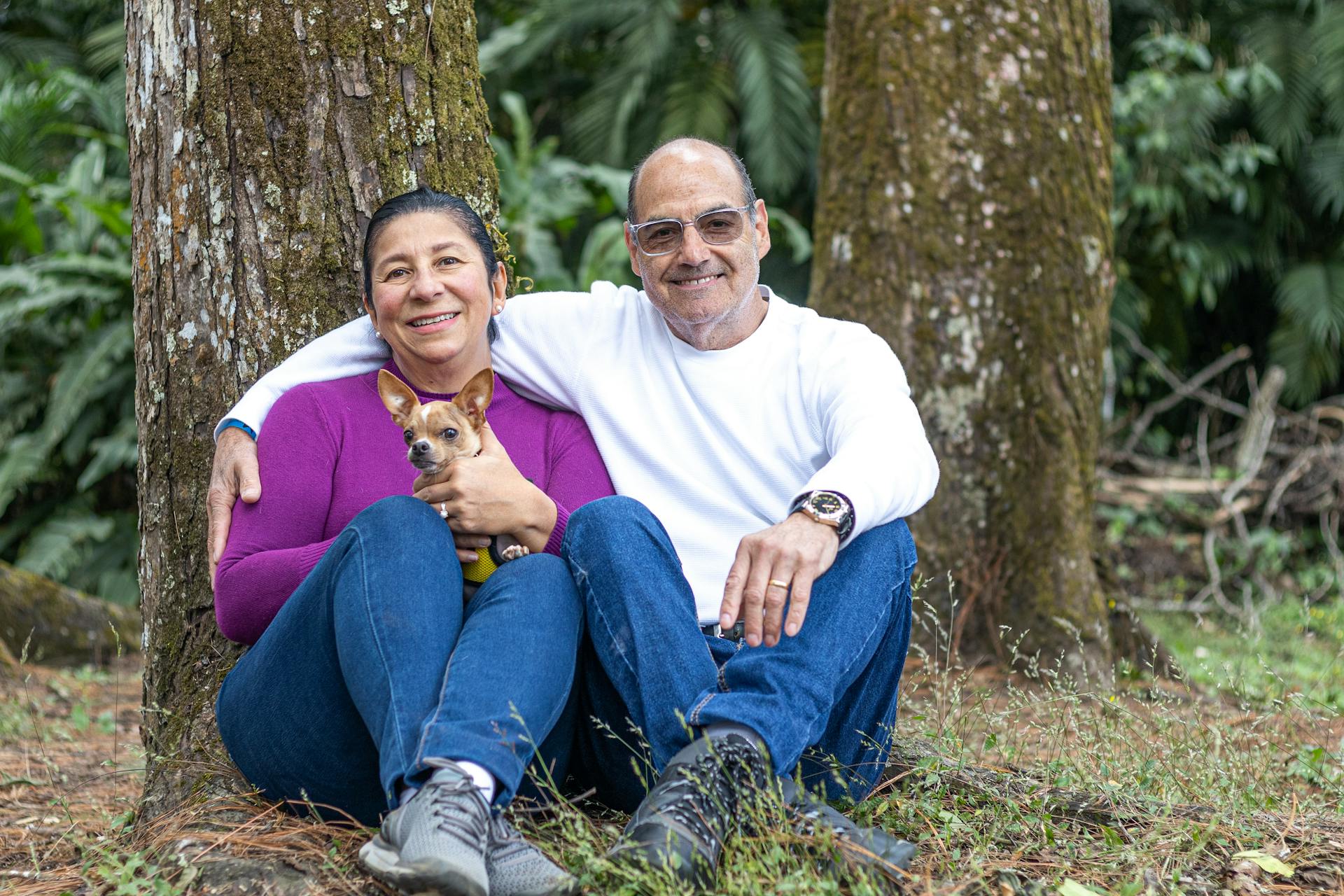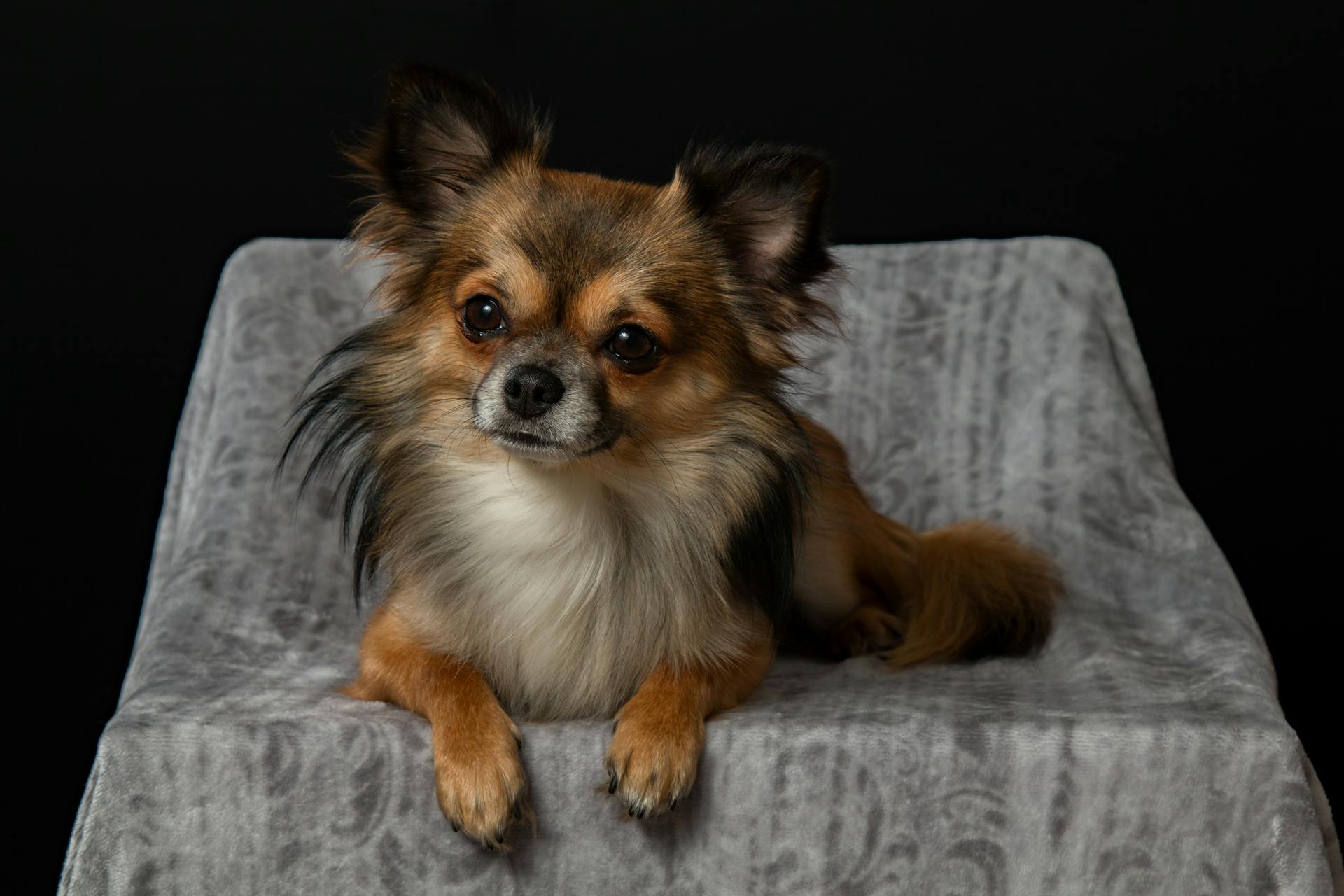
The Chihuahua Poodle Mix, also known as the Chipoo, is a crossbreed between a Chihuahua and a Poodle. They are a popular hybrid breed due to their low-shedding coat and small size.
One of the most notable characteristics of the Chihuahua Poodle Mix is their intelligence. They are highly trainable and can learn a wide range of commands and tricks. Their intelligence also makes them great problem solvers.
Their size is typically between 8-15 inches in height and weighs between 6-15 pounds. This makes them a great pet for apartment dwellers or those with small living spaces. They require regular grooming to prevent matting and tangling of their fur.
Their lifespan is generally between 12-18 years, which is relatively long compared to some other breeds.
Discover more: Wellness Dog Food for Small Dogs
What Is a Chihuahua Poodle Mix?
So, what is a Chihuahua Poodle mix? A Chi-poo, also known as a Poodle Chihuahua mix, is a mixed dog breed resulting from the crossbreeding of a Poodle and a Chihuahua.
These small, charming dogs inherit traits from both parent breeds, creating a unique and delightful companion. With their adorable appearance, friendly nature, and intelligence, Chi-poos have gained popularity.
Their low-shedding coats are highly sought after, and their small sizes make them apartment friendly. This is especially appealing to people with allergies or those living in small spaces.
In fact, Chi-poos are part of the "Doodle range" of Poodle mixes, which are increasing in popularity worldwide. They're often given cute combo names that reflect a bit of both parent names, a trend that's become popular in many countries.
Here are some examples of Poodle mixes and their cute names:
- Poodle x Cocker Spaniel – Cockapoo
- Poodle x Labrador – Labradoodle
- Poodle x Corgi – Corgipoo
- Poodle x Yorkshire Terrier – Yorkipoo
While Chi-poos may not be as popular as some of the other Doodle-dogs, they still make fun-loving family pets.
History and Origins
The Chi-poo's history is intertwined with its parent breeds and the development of designer dogs. This includes the popular "doodle" mixes.
The Chi-poo has a history that dates back years prior to focused breeding efforts, which began in the United States during the 1970s. This is around the same time as the development of the cockapoo.
The goal of creating the Chi-poo was to combine the poodle and Chihuahua to create a small dog with fewer health problems and grooming requirements.
Discover more: Grey Yorkie Poo
A History of Dog Breeds
The history of dog breeds is a fascinating topic. Chi poos, for instance, have a history intertwined with their parent breeds and the broader development of designer or mixed dogs, such as the popular "doodle" mixes.
Many designer breeds have been developed in recent years. The Chi-poo, a blend of Chihuahua, Poodle, and Doodle dogs, is one example of this trend.
The concept of designer breeds has been around for a while. The broader development of these breeds has led to the creation of many unique and interesting mixes.
Consider reading: German Doodle Dog
What Is the History of?
The history of Chihuahua Poodle mixes is a fascinating one. It's believed that they've been around for years prior to focused breeding efforts, which began in the United States during the 1970s.
Many breeders at the time were inspired by the development of the cockapoo, another popular hybrid breed. The goal was to create a small dog with fewer health problems and lower grooming requirements.
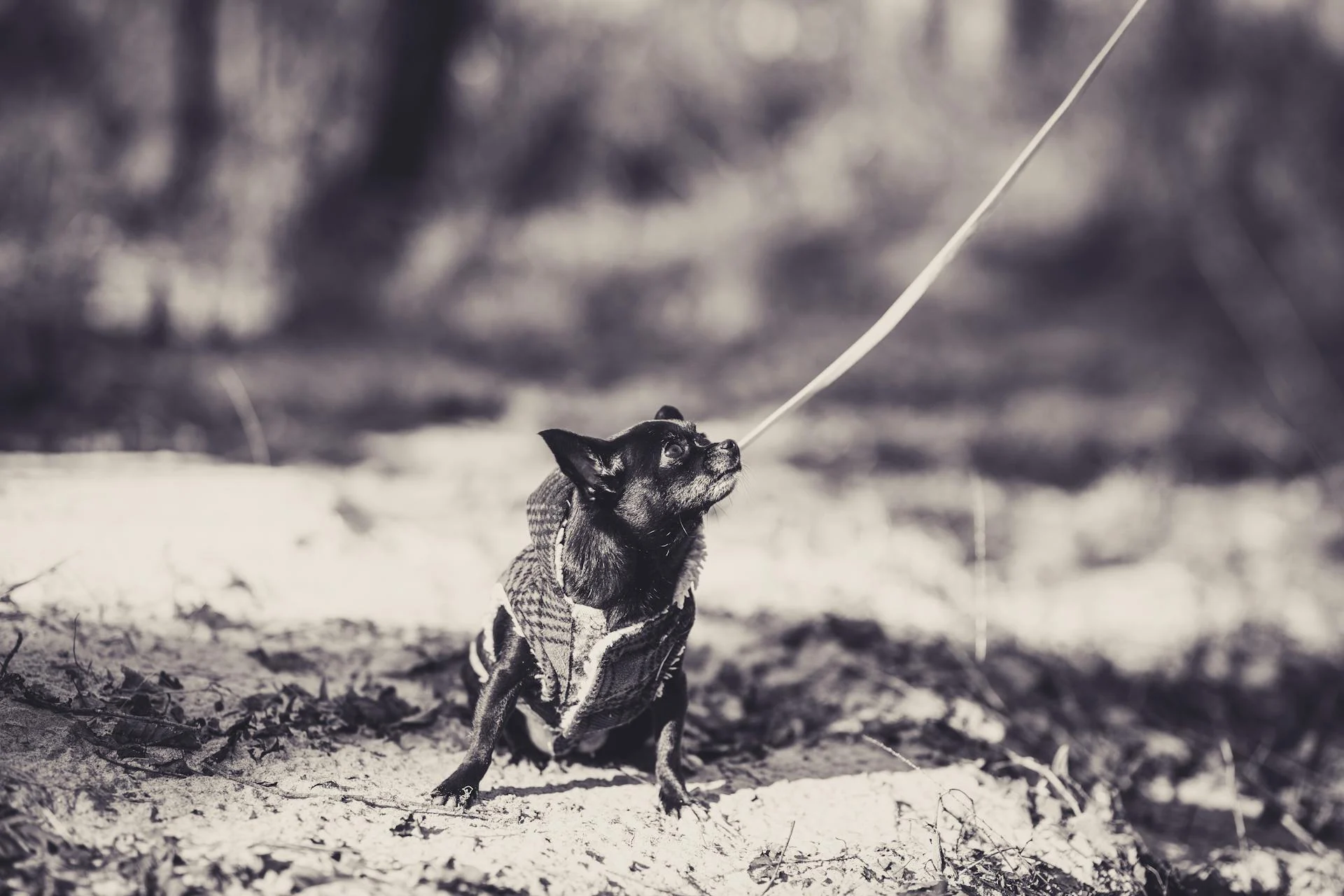
These factors contributed to the Chi-poo's popularity, and today they're sought-after by people around the world. Their designer breed status makes them expensive, but you may be able to find them in animal shelters.
The Chi-poo is not yet recognized by the American Kennel Club (AKC), but they are members of the American Canine Hybrid Club and the Designer Dogs Kennel Club.
Expand your knowledge: Yorkie Poodle and Chihuahua Mix
Physical Characteristics
The Chihuahua Poodle mix is a small-sized dog.
Their weight can vary between 5 to 20 pounds, depending on the size of the Poodle mix.
A Chi-poo typically stands at 5 to 15 inches tall.
Their coat can be curly, like the Poodle, or smooth and short like the Chihuahua.
Coat colors can vary widely, including black, white, brown, cream, golden, and combinations thereof.
Their ears can be floppy and feathered like a Poodle or more erect like a Chihuahua's.
The muzzle can be medium in length and may have a slight underbite, similar to a Chihuahua.
Broaden your view: Shiba Inu Coat
The Chi-poo's eyes can range from dark brown to hazel, depending on the coat color.
Their tail and hair around their forelegs can be similar to those of a Poodle.
Most Chi-poos have dark eye colors.
The Chi-poo's coat texture can depend on whether it takes after the Chihuahua's double coat that sheds or the Poodle's finely-textured coat that can get matted and tangled.
Coat and Grooming
The Chihuahua Poodle mix has a unique coat that's a hybrid of its two parent breeds. The coat can vary in texture and length, but there are three main types: curly/wavy, short, and combination.
These coat types require different levels of grooming, with curly/wavy coats needing regular brushing to prevent matting. Brushing at least two to three times a week is a good rule of thumb for this coat type.
Short coats, on the other hand, are low-maintenance and require minimal grooming. Occasional brushing is all you need to keep them clean and tidy.
Check this out: Two Corgis
Combination coats fall somewhere in between, requiring moderate grooming, including brushing and occasional trimming.
The coat color of a Chihuahua Poodle mix can also be quite varied, with common colors including cream, white, black, brown, tan, chocolate, silver, and parti-color.
Here's a rough guide to the grooming needs of a Chihuahua Poodle mix, based on coat type:
Some Chihuahua Poodle mixes may shed less than others, depending on their parents. However, regular ear cleaning, teeth brushing, and nail trimming are essential for their overall health and wellness.
A weekly brushing session with a pin brush can help prevent matting and tangling, while also spreading natural oils through their coat to keep their skin and coat healthy.
If your Chihuahua Poodle mix has a curly coat, you may need to bathe them more frequently, every three to four weeks, to prevent skin irritation.
It's also essential to clean their ears regularly to prevent infections and check their teeth regularly to prevent gum disease and tooth decay.
Ultimately, the grooming needs of a Chihuahua Poodle mix will depend on their individual coat type and needs.
Suggestion: Shiba Inu Exercise Needs
Temperament, Personality, Intelligence
Chi-Poos are people-oriented and tend to be very devoted, often bonding closely with a single person and ignoring everyone else.
They can be protective of their owners, barking excessively and acting tough when strangers come by, which makes them great watchdogs.
However, they also need extra socialization to ensure they're accepting of strangers when guests come to visit.
Chi-Poos are intelligent and can learn commands very easily, but they'll also need quite a bit of mental stimulation to prevent boredom and destructive behaviors.
They're known for being lively and affectionate, often full of energy, playful, and eager to please their owners.
Socialization from a young age is essential to ensure they're well-adjusted adults and don't become too protective or fearful.
A Chipoo is smart and energetic despite its small size, and it will get mischievous if it's bored, so early obedience training and mental stimulation are crucial.
They're loyal and close companions, happy and friendly with those they consider family, and they thrive on attention and human companionship.
Their lifespan is typically 12-15 years, so be prepared for a long-term commitment to providing love, care, and mental stimulation.
A different take: How Often Can You Put Flea Medicine on a Dog
General Health Care
As a Chi-poo owner, it's essential to prioritize their health care to ensure they live a long and happy life. Regular check-ups with a veterinarian can help catch conditions before they worsen.
Your Chi-poo may be prone to certain health issues, including dental problems, patellar luxation, eye problems, and allergies. To minimize the risk of these conditions, provide a balanced diet, maintain their grooming requirements, and ensure they receive regular exercise.
You should also be aware of the potential for hypoglycemia, especially in smaller Chi-poos, and take steps to prevent it by feeding them more frequently. A healthy weight and regular exercise can also help reduce the risk of patellar luxation.
Some common health issues in Chi-poos include:
- Dental problems: tooth decay, gum disease, and early tooth loss
- Patellar luxation: a condition where the kneecap temporarily dislocates
- Eye problems: cataracts, progressive retinal atrophy (PRA), and dry eye
- Allergies: food allergies and environmental allergies
- Collapsing trachea: a condition leading to coughing and wheezing
- Heart problems: heart murmurs, congestive heart failure (CHF), or mitral valve disease
- Legg-Calve-Perthes Disease: degeneration of the hip joint
- Hydrocephalus: excessive cerebrospinal fluid in the brain
It's also crucial to keep an eye out for signs of hyperactive tear glands, which can lead to gunk and hair around their eyes, and glaucoma, a pressure build-up behind their eyes that can cause permanent blindness. Regular grooming, including nail trimming and brushing their teeth, can also help prevent minor skin problems and other issues.
Exercise and Nutrition
A Chi-poo's exercise needs are relatively simple: they require 30-45 minutes of daily exercise and playtime, which can include activities like chasing, fetching, swimming, or even playing with other dogs in a dog park.
Daily walks, play sessions, and mental stimulation are essential for a Chi-poo's well-being, but they're also content with indoor play, making them suitable for apartment living. A mile-long walk a few times a day is usually sufficient.
A Chi-poo's small size means they don't need a lot of miles each day, but they do need to be actively engaged with their owners to get enough exercise. Without enough exercise, they can become overweight, which can cause significant issues.
To maintain a healthy weight, it's essential to provide a balanced diet that's highest in protein (at least 25%). Choose high-quality dog food that's appropriate for their size, age, and activity level, and aim to feed them 3 to 4 times daily.
Readers also liked: Dog Play Daycare
Exercise
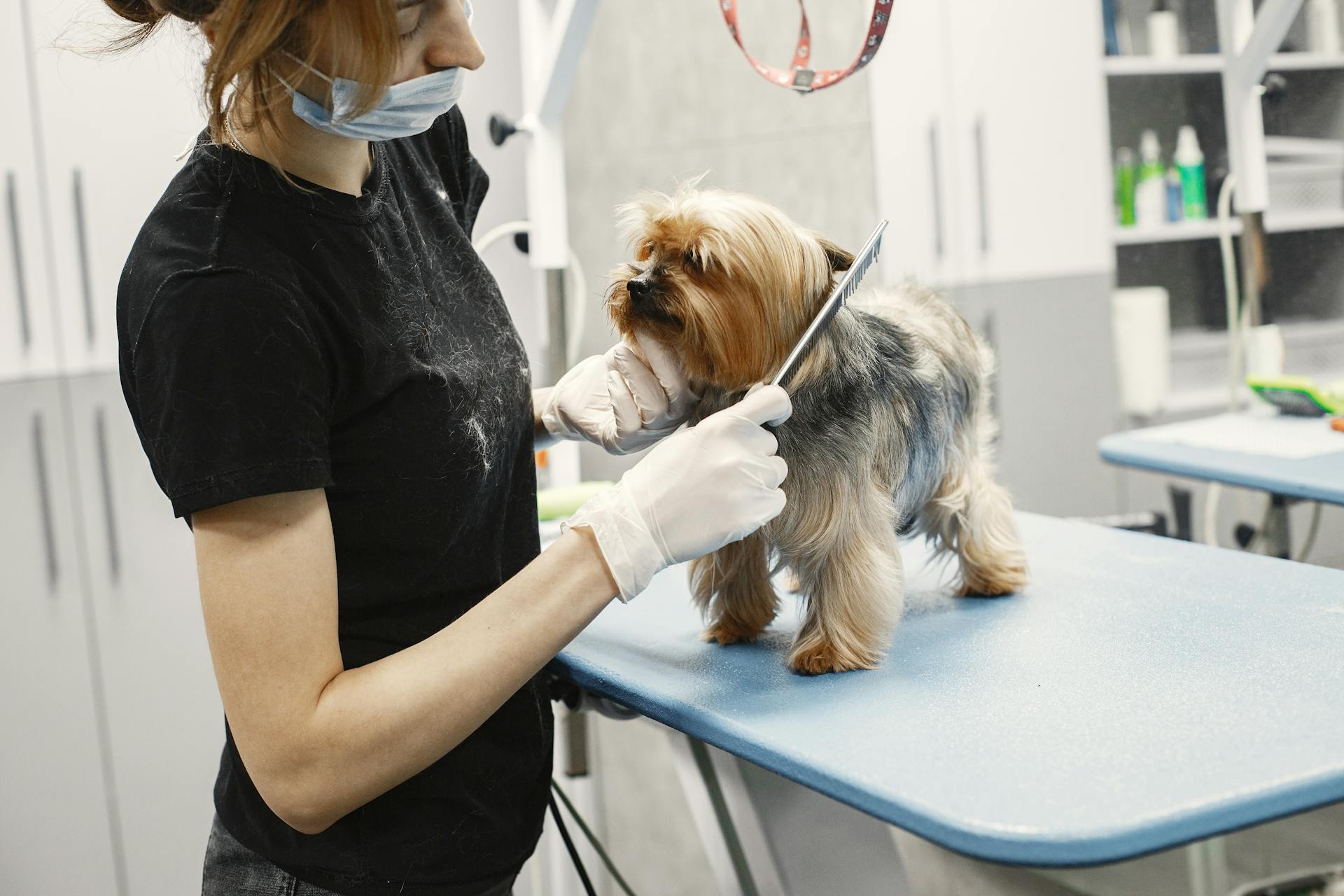
Exercise is crucial for Chi-poos, and it's essential to understand their needs to ensure they stay healthy and happy. Aim for at least 30 minutes to an hour of exercise daily, adjusting it based on your Chi-poo's individual energy levels and size.
Supervising your Chi-poo during outdoor activities is vital to ensure their safety. A mile-long walk a few times a day and play sessions in the yard are usually sufficient for them. You can't simply leave your dog in the backyard and expect them to get enough exercise.
Daily walks, play sessions, and mental stimulation are essential for your Chi-poo's well-being. They require regular exercise, and daily exercise and playtime, such as chase, fetch, and swimming, are ideal.
Nutrition
Feeding your Chi-poo a balanced diet is crucial to maintaining their health and energy.
High-quality commercial dog food, proportionate to their size and activity level, is typically recommended.
Their Chihuahua size makes them susceptible to stomach issues if they eat diets riddled with fillers, by-products, and chemicals.
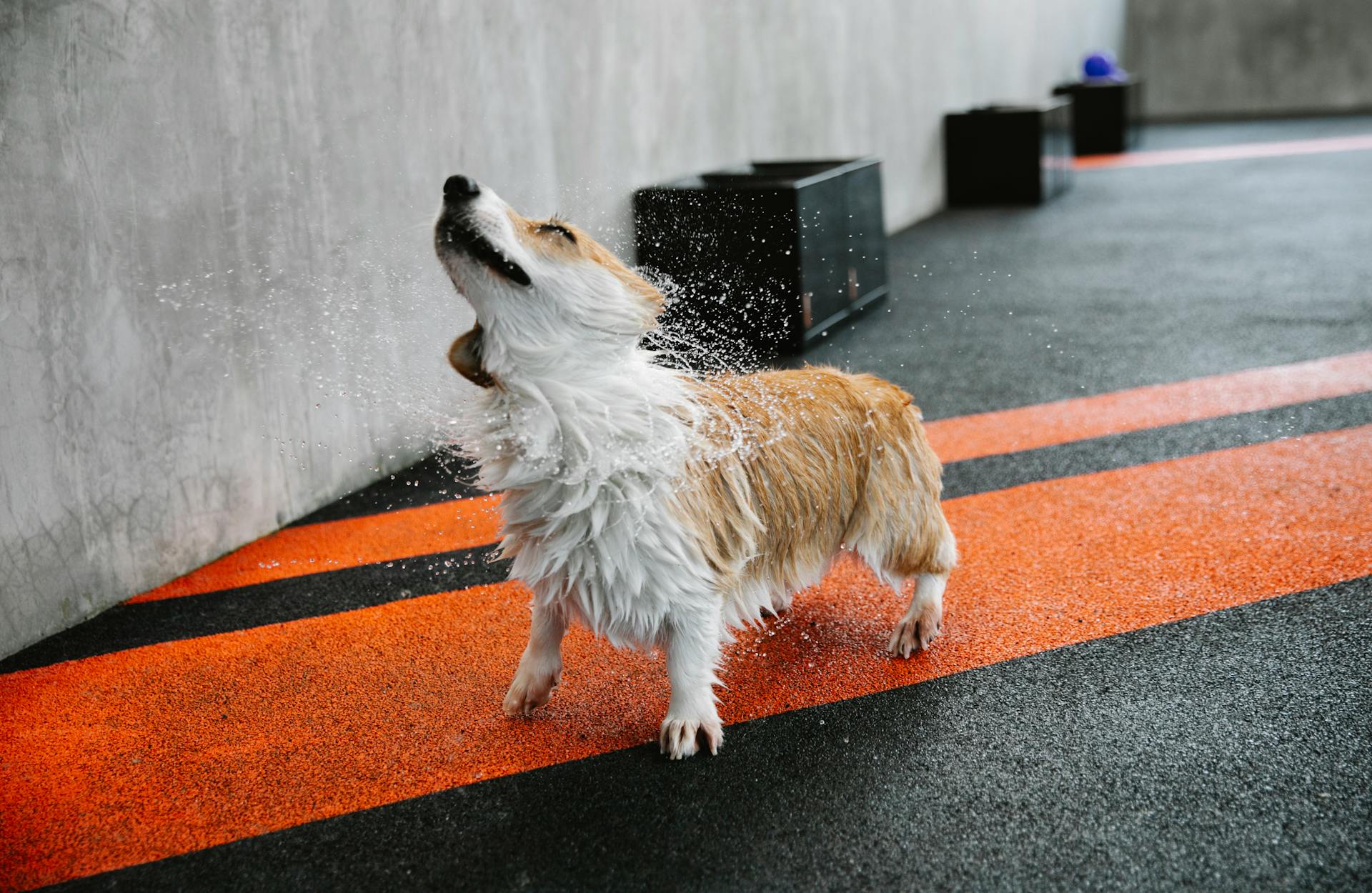
Feeding them 3 to 4 times daily can help avoid hypoglycemia, or low blood pressure.
A small-breed formula is suitable for Chi-Poos, and they can thrive on it.
Avoiding dog foods with high amounts of fillers and low-quality ingredients is essential.
On average, feed your Chi-poo half to one cup of kibble per day, depending on their activity level.
Purchasing higher-quality food can help your dog avoid health problems later on.
Training
Training a Chi-poo requires patience and consistency, as they can be quite a handful and may exhibit a stubborn streak at times.
Early socialization and obedience training are crucial to help Chi-poos develop good manners and become confident canines. Positive reinforcement methods work best with them, such as using treats, praise, and rewards for desired behaviors.
Chi-poos are intelligent and active, and need to be trained early to prevent boredom and destructive behavior. They need to be kept occupied to stop boredom and from getting up to mischief; chewing, barking or destroying things.
For another approach, see: Training a Dog to Protect
A Chipoo puppy needs exposure to different situations and people early, and practice leaving it alone to help it manage its feelings of separation anxiety, but with you close by. This will help prevent it from getting anxious and yapping when left alone.
Positive reinforcement and small treats work best for Chi-poos, as they like to please and be praised. Reward-based training is the way to go, never aggressive treatment.
Early leash training is recommended for Chi-poos, as they are playful and full of energy. Practice voice commands and road safety awareness firmly but not harshly.
Training a Chi-poo requires a combination of gentle physical and mental challenges, possibly in short sessions. This is because they have short legs and over strenuous exercise could damage their legs and especially their knees.
Chi-poos are intelligent and easy to train, but may require more effort and patience than other breeds. Consistency, positive reinforcement, and early socialization are key to raising a well-behaved Chi-poo.
Related reading: Can Bichon Frise Be Left Alone
Family and Lifestyle
Chi-Poos can make great family pets, but they do require some special attention. They are generally good with children, especially when they're raised and socialized with them from an early age.
However, due to their small size, it's essential to supervise interactions between Chi-Poos and young children to prevent accidental injuries. This is especially true if you have a Chi-Poo that's still getting used to being around kids.
Chi-Poos are active dogs that love to have fun and stay active, which means they need a lot of attention and exercise. They're not suited for cold weather, so if you live in a chilly climate, you'll need to make arrangements for them to stay warm and comfortable.
Here are some key characteristics to consider when deciding if a Chi-Poo is right for your family:
- Active and stubborn
- Bonds closely and can suffer from separation anxiety
- Hard to potty train
- Can be yappy, not stranger friendly!
- Bores easily, will bark and chew things
- Small dog, delicate to handle
- Might not be hypoallergenic
It's worth noting that Chi-Poos can be one-person dogs, meaning they tend to bond closely with one person to the exclusion of everyone else. This can be a challenge for families who want their dog to be a part of the group dynamic.
Discover more: My Dog Bit the Amazon Delivery Person
Cost and Considerations
A Chipoo puppy can cost a pretty penny, so be prepared for a significant upfront expense. Be careful of fake breeders offering bargain puppies, as they could come from puppy mills.
You should expect to spend around $20-$30 per month on food for your Chipoo, but that's not the only cost to consider. Factor in vet's fees, accessories, and toys, which can add up quickly.
A good quality dry dog food, kibble, is essential for your Chipoo's health and well-being. Regular vaccinations, medications, and accessories like a collar, leash, and grooming equipment are also necessary expenses.
Training fees can vary depending on the method and frequency, but they're a crucial part of raising a well-behaved Chipoo.
You might like: Dog Boarding Dallas Cost
Frequently Asked Questions
How big does a chi-poo grow?
A Chi-Poo typically grows to 5-15 inches tall at the shoulder and weighs 5-20 pounds, depending on the size of the Poodle parent. Their size can vary, but they usually remain a small to medium-sized dog.
Is a Chipoo a designer dog?
Yes, a Chipoo is a designer dog, specifically a hybrid breed resulting from crossing a Chihuahua and a Poodle. This unique mix makes Chipoos a popular choice for those seeking a small, low-shedding companion.
Do Chihuahua poodles bark a lot?
Chihuahua poodle mixes can be prone to barking if not trained, but with proper training, they can learn to be calm and alert watchdogs. Barking at strangers is a common trait in this breed, but it's not necessarily excessive.
Are chipoos good dogs?
Yes, Chipoos are known for being affectionate, playful, and adaptable companions, making them a great choice for many families. With proper care and attention, they can thrive as loving and loyal pets.
What is the lifespan of a chipoo dog?
A Chipoo's average lifespan is 12 to 15 years. With proper care, they can live a long and happy life.
Featured Images: pexels.com
